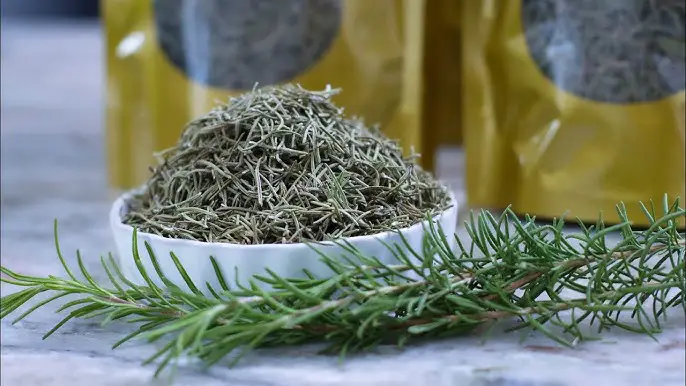Rosemary is a fragrant and flavorful herb that elevates dishes, teas, and home décor. Gardeners and cooks value its aromatic leaves and robust taste. Without proper storage, rosemary loses its freshness and flavor quickly. Learning simple, effective storage methods keeps the herb vibrant and ready for use throughout the year.
Storing rosemary correctly extends its lifespan and prevents waste. You can enjoy fresh, dried, or frozen leaves for cooking, decoration, or aromatherapy. By applying practical storage techniques, you maintain the herb’s aroma, taste, and visual appeal. With a little care, rosemary stays lively and fragrant, providing consistent culinary and decorative benefits whenever needed.
Choosing the Right Rosemary for Storage

Selecting the right rosemary is the first step to ensuring long-lasting freshness and flavor. Healthy, vibrant sprigs with deep green leaves contain the highest concentration of essential oils, which preserve aroma and taste. Avoid leaves that are yellowing, wilted, or damaged, as they deteriorate faster and can affect the quality of stored herbs. Picking rosemary at its peak, either from the garden or store, guarantees maximum potency and longevity.
Consider the variety of rosemary when preparing for storage. Some cultivars have tender stems ideal for drying or freezing, while others feature robust, woody stems better suited for decorative uses. Knowing the growth habits and leaf texture of your rosemary helps determine the best storage method. Younger, soft stems retain flavor better when frozen, whereas mature, woody stems excel in air-dried bundles for long-term use.
Timing also plays a crucial role in selecting rosemary for storage. Harvest in the morning, after dew has dried, to capture the peak essential oil content. Avoid harvesting after heavy rain or during extreme heat, which can reduce flavor and cause spoilage. By carefully choosing healthy, suitable sprigs at the right time, gardeners and cooks set the foundation for successful storage, ensuring that rosemary remains fragrant, flavorful, and visually appealing for months to come.
Preparing Rosemary for Storage
Proper preparation before storing rosemary ensures that the herb retains maximum flavor and aroma. Begin by gently rinsing the sprigs under cool water to remove dust, dirt, or small insects. Avoid soaking the leaves, as excess moisture can promote mold and spoilage. Pat the sprigs dry carefully with a clean cloth or paper towel to remove any lingering water, which helps prevent bacterial growth during storage.
Trimming the stems also improves storage efficiency. Remove any damaged, yellowed, or woody leaves to maintain consistent quality. Shorten the stems to a manageable length suitable for your chosen storage method, whether it is freezing, drying, or placing in containers. Properly prepared sprigs not only fit neatly into storage vessels but also dry evenly or freeze more efficiently, preserving both flavor and essential oils.
Organization plays a key role in preparation. Separate rosemary into batches based on size and intended use. Smaller, tender sprigs are ideal for immediate cooking or freezing, while larger, more robust stems work well for long-term drying. Arranging the herb in this way streamlines storage and ensures that the rosemary remains accessible and usable without damage. Taking these careful preparation steps allows gardeners and cooks to preserve rosemary at its peak, providing fresh, fragrant herbs for months to come.
Storing Fresh Rosemary
Keeping rosemary fresh requires proper storage techniques to preserve flavor, aroma, and texture. One of the simplest methods is to place trimmed sprigs in a glass of water, similar to cut flowers. Covering them loosely with a plastic bag helps retain humidity and prevents leaves from drying out. Change the water every two to three days to avoid bacterial growth, ensuring the rosemary remains vibrant and aromatic for longer periods. Proper placement in the refrigerator or on a cool counter further extends freshness.
Refrigeration is particularly effective for sprigs that won’t be used immediately. Wrap rosemary loosely in a damp paper towel and place it inside a resealable plastic bag or an airtight container. This creates a humid microenvironment that slows leaf dehydration while protecting essential oils. Avoid tightly sealing without moisture, as condensation can promote mold or decay. Check stored rosemary regularly for signs of wilting, yellowing, or slimy leaves, and remove any damaged pieces promptly to prevent spoilage of remaining sprigs.
For gardeners or cooks with a large harvest, freezing rosemary offers long-term convenience. Spread sprigs in a single layer on a baking sheet and freeze briefly before transferring them to airtight containers or freezer bags. This prevents clumping and preserves the herb’s flavor and aroma. Frozen rosemary can be used directly in cooking, soups, and sauces without thawing, saving time while maintaining quality. By selecting the right storage method, you can enjoy fresh, aromatic rosemary year-round, reduce waste, and maximize its culinary and decorative potential.
Drying Rosemary for Long-Term Storage
Drying rosemary is an effective way to preserve its flavor, aroma, and essential oils for extended periods. Begin by selecting healthy, vibrant sprigs, avoiding any yellowed or damaged leaves. Gently rinse the sprigs to remove dirt and insects, then pat them dry to prevent mold during the drying process. Properly prepared rosemary retains its fragrance and taste, ensuring it remains a valuable ingredient for cooking, teas, and decorative purposes.
There are several drying methods suitable for rosemary. Air-drying is traditional and simple: tie small bundles of rosemary with string and hang them upside down in a cool, dry, and well-ventilated area. Avoid direct sunlight, as it can fade the leaves and degrade essential oils. The drying process typically takes one to two weeks, depending on humidity and airflow. Oven-drying and using a food dehydrator are faster alternatives, but careful temperature control is essential to prevent burning or loss of flavor.
Once completely dry, strip the leaves from the stems and store them in airtight containers. Dried rosemary keeps its flavor for several months if stored in a cool, dark location. Labeling containers with the date ensures freshness and easy rotation. Using dried rosemary allows you to enjoy its aromatic and flavorful qualities year-round, whether in cooking, infusions, or decorative arrangements. By mastering drying techniques, gardeners and cooks can maintain a reliable, long-lasting supply of rosemary while reducing waste and preserving its culinary potential.
Freezing Rosemary for Extended Freshness
Freezing rosemary provides a convenient method to preserve its flavor, aroma, and essential oils for months. Begin by selecting healthy, tender sprigs that are free from yellowing, wilted, or damaged leaves. Rinse the sprigs gently under cool water to remove dust or insects, then pat them dry completely. Excess moisture can form ice crystals during freezing, which may damage the leaves and reduce flavor. Preparing rosemary carefully ensures that frozen sprigs retain their aromatic qualities and texture for long-term use in cooking, teas, and infusions.
For best results, arrange the sprigs in a single layer on a baking sheet or tray before placing them in the freezer for several hours. This quick-freeze technique prevents sprigs from sticking together and allows easy portioning later. Once frozen, transfer rosemary to airtight containers or heavy-duty freezer bags. Press out excess air to minimize freezer burn and preserve flavor and color. Label each container with the date to track freshness. Additionally, consider freezing chopped rosemary in ice cube trays with a little water or olive oil, creating ready-to-use portions for soups, sauces, and sautés.
Frozen rosemary can be used directly in cooking without thawing, which saves time and maintains its aromatic oils. Tender leaves retain nearly the same flavor as fresh rosemary, while woody stems remain suitable for long-cooked dishes. Store containers in the coldest part of the freezer and avoid repeated thawing and refreezing. By following these careful steps, gardeners and cooks can maintain a reliable supply of aromatic rosemary year-round, reducing waste and ensuring that every dish benefits from the herb’s vibrant, natural character.
Tips for Maximizing Flavor and Aroma During Storage
Proper Handling Before Storage
Handling rosemary correctly before storage is essential for preserving its flavor, aroma, and overall quality. Begin by selecting healthy, vibrant sprigs free from yellowing, wilting, or damaged leaves. Rinse gently under cool water to remove dust, insects, or residual soil, then pat dry thoroughly with a clean towel. Excess moisture can encourage mold growth or spoilage during refrigeration, freezing, or drying. Trimming stems to manageable lengths not only makes storage easier but also ensures even drying and proper air circulation around each sprig.
Organizing rosemary according to its intended storage method further protects flavor and essential oils. Tender, young sprigs are perfect for freezing or immediate culinary use, while older, more robust stems hold up better during long-term drying. Labeling sprigs by harvest date or storage method can help rotate stock efficiently and reduce waste. Additionally, lightly crushing or bruising rosemary leaves just before cooking can release aromatic oils, but this should be avoided before storage to maintain potency. Proper handling and preparation of rosemary before storing set the foundation for long-lasting freshness, superior flavor, and vibrant aroma, whether the herb is kept in the kitchen, pantry, or freezer for year-round culinary enjoyment.
Choosing the Right Storage Conditions
Maintaining optimal storage conditions is crucial for preserving rosemary’s flavor, aroma, and essential oils. For fresh rosemary, a cool and slightly humid environment works best. Wrapping sprigs loosely in damp paper towels and placing them inside a resealable plastic bag or container prevents dehydration while avoiding excess moisture that could encourage mold. Refrigerators with stable temperatures are ideal, as fluctuating heat or cold can reduce shelf life and diminish aromatic compounds.
For frozen rosemary, using airtight containers or heavy-duty freezer bags minimizes air exposure, preventing freezer burn and preserving color and taste. Arrange sprigs in a single layer for quick freezing before transferring them to storage containers. Dried rosemary should be stored in a cool, dark place away from direct sunlight, heat, and humidity to protect essential oils. Regularly monitoring stored rosemary ensures it stays vibrant and aromatic. Remove any sprigs showing signs of wilting, discoloration, or mold. By carefully controlling storage conditions, gardeners and cooks can maximize flavor, extend shelf life, and enjoy rosemary at peak quality year-round.
Sustainability and Year-Round Availability
Growing and storing rosemary sustainably ensures a continuous supply of fresh, aromatic herbs throughout the year. Choosing organic or chemical-free cultivation methods protects the environment and promotes healthy plant growth. Regularly harvesting rosemary with care, taking only what is needed, encourages bushier growth and prevents waste. Maintaining soil fertility with natural compost or mulch reduces the need for synthetic fertilizers and supports long-term plant health.
Proper storage techniques, such as drying, freezing, or refrigerating, allow gardeners to use rosemary well beyond the harvest season. By preserving excess harvest, less plant material is discarded, contributing to sustainable gardening practices. Additionally, storing rosemary in small, manageable batches ensures minimal spoilage and maintains maximum flavor and aroma. This approach also enables gardeners and cooks to enjoy rosemary year-round, regardless of seasonal availability.
Integrating sustainable practices into rosemary cultivation and storage not only benefits the environment but also enhances culinary experiences. Sharing excess herbs with friends, neighbors, or local communities encourages resourcefulness and reduces food waste. By combining careful harvesting, proper storage, and mindful consumption, gardeners can maintain a reliable, aromatic supply of rosemary throughout the year. Sustainability ensures that this versatile herb continues to enrich dishes, teas, and decorations while supporting ecological balance and long-term herb garden productivity.
Using Rosemary in Culinary Applications After Storage
Properly stored rosemary retains its aromatic oils and flavor, making it ideal for a wide range of culinary applications. Whether frozen, dried, or refrigerated, rosemary can elevate soups, stews, roasted meats, and vegetable dishes. For frozen sprigs, add them directly to hot dishes without thawing, which preserves their aroma and reduces preparation time. Dried rosemary works well in slow-cooked recipes, releasing its flavor gradually, while fresh refrigerated rosemary is perfect for garnishing and finishing dishes with a vibrant, herbal note.
Using rosemary effectively also involves understanding how different storage methods impact flavor. Frozen rosemary maintains most of its original taste, but prolonged storage can slightly reduce its intensity. Dried rosemary concentrates in flavor, so less is needed in recipes compared to fresh sprigs. For best results, chop or crush rosemary just before adding it to dishes. This releases essential oils and enhances the herb’s natural aroma. Pairing rosemary with complementary ingredients like garlic, lemon, olive oil, or roasted vegetables can further highlight its flavor, creating rich, memorable meals that showcase the herb’s versatility.
In addition to traditional dishes, stored rosemary can be incorporated into marinades, infused oils, and herb butters. These preparations allow the herb’s flavor to permeate proteins or vegetables over time, creating deeper, more complex tastes. Even when stored for months, rosemary retains enough aromatic potency to transform simple meals into flavorful culinary experiences. By understanding the characteristics of rosemary after storage and using it thoughtfully in recipes, cooks can enjoy the herb’s full potential year-round, ensuring every dish benefits from its distinctive fragrance and taste.
Decorative and Aromatic Uses of Stored Rosemary
Stored rosemary is not only useful in the kitchen but also offers versatile decorative and aromatic applications. Fresh, refrigerated sprigs can be incorporated into wreaths, garlands, or floral arrangements, providing a lasting green accent and a natural fragrance. Dried rosemary is perfect for crafting sachets, potpourri, or scented candles, filling indoor spaces with a subtle, herbal aroma that promotes relaxation and well-being. By using stored rosemary creatively, gardeners and cooks can extend the herb’s utility beyond cooking.
Proper preparation and storage enhance the herb’s decorative value. For instance, freezing sprigs preserves their color and texture, making them suitable for seasonal arrangements. Dried rosemary should be kept in cool, dark conditions to retain its green hue and prevent brittleness. Using rosemary in these ways not only recycles excess harvest but also adds natural beauty to homes without relying on synthetic fragrances. Simple touches, like placing a few sprigs in a small vase or tying them with ribbon, can bring charm and freshness to any room.
In addition to aesthetics, rosemary’s aromatic properties make it an effective natural air freshener. Stored rosemary can be combined with other dried herbs, such as lavender or thyme, to create custom-scented blends for kitchens, bathrooms, or living areas. The herb’s essential oils release slowly over time, providing long-lasting fragrance without overpowering the senses. By integrating rosemary into decorative and aromatic uses, households can enjoy both visual appeal and herbal aroma year-round, maximizing the benefits of every harvest.
Common Storage Mistakes and How to Avoid Them
Overexposure to Moisture
One of the most frequent storage mistakes is exposing rosemary to excessive moisture. Fresh or thawed sprigs that remain wet can quickly develop mold, reducing their flavor, aroma, and shelf life. Even when refrigerating, overly damp paper towels or tightly sealed containers create a humid environment that encourages bacterial growth. Moisture also causes leaves to yellow, wilt, or become slimy, compromising both culinary and decorative uses. Unchecked, these conditions may ruin an entire batch of rosemary in a few days.
To avoid this issue, always dry rosemary thoroughly before storage. Pat leaves gently with a clean towel or allow them to air-dry after rinsing. For refrigeration, loosely wrap sprigs in slightly damp but not wet paper towels and place in perforated bags or containers to maintain moderate humidity. Frozen rosemary should be pre-dried and wrapped in parchment or paper towels to prevent ice crystals. Controlling moisture ensures rosemary retains its green color, texture, and essential oils, maintaining peak quality for cooking, infusions, or decorative purposes over weeks or months.
Exposure to Heat and Light
Another common mistake is storing rosemary in areas with excessive heat or direct sunlight. High temperatures degrade essential oils, causing the herb to lose fragrance and flavor. Sunlight also fades leaves, leaving rosemary less vibrant and visually unappealing. Continuous exposure to heat accelerates moisture loss, making sprigs dry and brittle, which diminishes both culinary utility and aesthetic value. Improper storage reduces the overall effectiveness of the herb for cooking, teas, or home decor.
To prevent heat and light damage, keep rosemary in cool, dark locations away from windows, stoves, and other heat sources. Dried rosemary should be stored in airtight, opaque containers to block light while preventing air exposure. Refrigerated or frozen sprigs should remain in the coldest areas of the appliance, minimizing temperature fluctuations. Regular inspection removes any compromised sprigs promptly, ensuring only healthy, aromatic rosemary is used. Proper storage preserves essential oils, flavor, and appearance, maximizing the usefulness of every harvest.
Preserving Rosemary Nutrients and Essential Oils
Maintaining the nutrients and essential oils in rosemary is crucial for maximizing both flavor and health benefits. Fresh rosemary contains antioxidants, vitamins, and volatile oils that enhance culinary dishes and provide therapeutic value. Improper storage can quickly degrade these compounds. Exposure to heat, sunlight, and excessive moisture reduces the herb’s potency, diminishes its aroma, and impacts overall quality. Dried rosemary may retain most essential oils, but careless handling or storage can compromise its effectiveness for cooking, teas, or herbal remedies.
Proper storage techniques help retain rosemary’s natural nutrients and oils. Dried rosemary should be placed in airtight, opaque containers in a cool, dark location, away from sunlight or heat sources. Avoid frequent opening of containers, as repeated air exposure can reduce essential oil content. Frozen rosemary should be tightly wrapped to prevent condensation and freezer burn, which can weaken both flavor and nutrients. For fresh sprigs, refrigeration in lightly wrapped, perforated bags keeps leaves hydrated without trapping excess moisture, preserving volatile oils that contribute to aroma and taste.
Timing also plays a role in preserving quality. Even under ideal conditions, essential oils gradually diminish over time, so it is best to use stored rosemary within a few months for maximum flavor and nutrient retention. Crushing or chopping rosemary just before use helps release its oils, enhancing both aroma and potency. By carefully managing storage conditions and handling rosemary thoughtfully, gardeners and cooks can enjoy the herb’s full nutritional and aromatic potential throughout the year, ensuring vibrant flavor, health benefits, and aromatic intensity in every dish or application.
FAQ About Storing Rosemary
How long can rosemary last when stored properly?
Properly stored fresh rosemary can last up to two weeks in the refrigerator. Frozen rosemary may retain quality for six months, while dried rosemary stored in airtight containers can remain flavorful and aromatic for up to a year. Storage conditions, such as humidity and temperature, significantly affect longevity.
Can I freeze rosemary without losing flavor?
Yes, freezing rosemary preserves its flavor if prepared correctly. Trim sprigs, remove excess moisture, and wrap them in parchment or freezer-safe bags. Freezing helps retain essential oils and aroma. Avoid thawing and refreezing, as this can degrade texture, flavor, and potency, reducing culinary quality.
Is it better to dry or freeze rosemary for long-term use?
Both methods are effective, but the choice depends on intended use. Drying rosemary concentrates flavor for long-term culinary or aromatic applications. Freezing preserves color, texture, and essential oils better, ideal for recipes needing fresh-like taste. Proper technique ensures maximum flavor in either method.
How should I handle rosemary before storage?
Select healthy, undamaged sprigs and remove yellowing leaves. Rinse gently to remove dirt or insects, then dry thoroughly to prevent mold. Trim stems for easier storage in containers or bags. Proper handling ensures essential oils and flavor remain intact for cooking, freezing, or drying.
What are common storage mistakes to avoid?
Avoid excessive moisture, direct sunlight, and heat exposure. Overcrowding sprigs or storing wet rosemary can cause mold or loss of essential oils. Use cool, dark, airtight containers for dried or refrigerated rosemary, and minimize air exposure. Proper storage preserves aroma, flavor, and nutrients for extended use.
Conclusion
Properly storing rosemary ensures that this versatile herb maintains its flavor, aroma, and nutritional benefits year-round. By selecting healthy sprigs, managing moisture, and protecting against heat and light, gardeners and cooks can extend shelf life while preserving essential oils. Whether using fresh, frozen, or dried rosemary, thoughtful handling enhances culinary, decorative, and aromatic applications. Avoiding common storage mistakes ensures maximum potency and visual appeal. With consistent care and attention to storage methods, rosemary remains a reliable, aromatic, and flavorful addition to every kitchen, craft project, and herbal remedy, providing enjoyment throughout the seasons.






